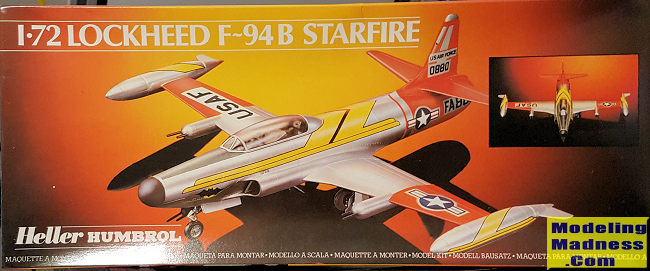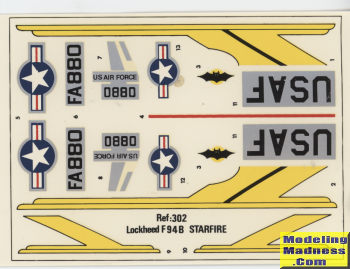
Heller 1/72 F-94B Starfire
| KIT #: | 302 |
| PRICE: | $10.00 when new |
| DECALS: | One option |
| REVIEWER: | Scott Van Aken |
| NOTES: | resin parts. |

| HISTORY |
The fire control system was the Hughes E-1, which incorporated an AN/APG-33 radar (derived from the AN/APG-3, which directed the Convair B-36's tail guns) and a Sperry A-1C computing gunsight. This short-range radar system was useful only in the terminal phases of the interception. Most of the operation would be directed using ground-controlled interception, as was the case with the earlier aircraft it replaced.
The added weight of the electronic equipment required a more powerful engine, so the standard Allison J33A-35 centrifugal turbojet engine, which had been fitted to the T-33A, was replaced with a more powerful afterburning version, the J-33-A-33. The combination reduced the internal fuel capacity. The F-94 was to be the first US production jet with an afterburner. The J33-A-33 had standard thrust of 4,000 pounds-force (18 kN), and with water injection this was increased to 5,400 lbf (24 kN) and with afterburning a maximum of 6,000 lbf (27 kN) thrust. The YF-94A's afterburner had many teething problems with its igniter and the flame stabilization system.
The subsequent F-94B, which entered service in January 1951, was outwardly virtually identical to the F-94A, and dealt with many of the negative issues with the earlier version. The Allison J33 turbojet had a number of modifications made, which made it a very reliable engine; the pilot was provided with a more roomy cockpit and the canopy was replaced by a canopy with a bow frame in the center between the two crew members, as well as a new Instrument Landing System (ILS). 356 of these were built. It proved in service to be a very reliable aircraft with relatively few problems. As they replaced the F-94As in service with the active-duty squadrons, the older models were sent to Lockheed to be re-engined and modified to F-94B standards. These upgraded F-94A/B aircraft were also modified with a twin-gun pod under each wing for two additional 0.50 in (12.7 mm) machine guns each, bringing the total to eight. These aircraft were then passed along to Air National Guard units where they served until the end of the 1950s.
| THE KIT |
 Heller
stopped producing new kits before engraved panel lines became standard in kit so
none that I've ever seen are anything but the raised external detailing type.
Since Heller produced a T-33, it is not surprising that this kit is laid out
pretty much the smae way. The cockpit tub has two seat shapes, a forward control
stick and instrument panel and the large rear seat radar scope piece. The nose
gear well is glued to the lower part of the cockpit tub and a nose gear with
wheel is cemented in place. You can leave the gear off until after painting.
Heller
stopped producing new kits before engraved panel lines became standard in kit so
none that I've ever seen are anything but the raised external detailing type.
Since Heller produced a T-33, it is not surprising that this kit is laid out
pretty much the smae way. The cockpit tub has two seat shapes, a forward control
stick and instrument panel and the large rear seat radar scope piece. The nose
gear well is glued to the lower part of the cockpit tub and a nose gear with
wheel is cemented in place. You can leave the gear off until after painting.
 Intake
blanking plates and an exhaust is installed into the fuselage halves along with
an unspecified amount of weight before the cockpit is trapped between the
fuselage halves. This kit has a single lower wing with upper wing halves. A hole
needs to be opened in the lower wings for the wing's gun pods. Then the wing
assembly, stabs and cockpit canopy are attached. The canopy in my kit is short
shot and finding a replacement may prove difficult.
Intake
blanking plates and an exhaust is installed into the fuselage halves along with
an unspecified amount of weight before the cockpit is trapped between the
fuselage halves. This kit has a single lower wing with upper wing halves. A hole
needs to be opened in the lower wings for the wing's gun pods. Then the wing
assembly, stabs and cockpit canopy are attached. The canopy in my kit is short
shot and finding a replacement may prove difficult.
Note that the wing tip tanks are molded onto the wing halves. Last construction is the gun pods, the speed brakes, which can be posed lowered, along with the main landing gear and gear doors. I can tell you from experience that getting all the gear doors in place will take some fussing as there is no really positive locator for them. Note also that the outside of the gear doors have sink areas on them that should be filled.
 Instructions
have four construction steps in exploded view form on one side and painting info
on the other. All colors are in Heller/Humbrol paint numbers. The lone markings
option is the very colorful box art plane from the 59th FIS based in Iceland in
1954. The red areas will all need to be painted. Fortunately, the decals have a
silver surround where they fit over the red so that is a big help. My kit was
sealed until opened for this preview so the decals appear to still be in quite
good condition.
Instructions
have four construction steps in exploded view form on one side and painting info
on the other. All colors are in Heller/Humbrol paint numbers. The lone markings
option is the very colorful box art plane from the 59th FIS based in Iceland in
1954. The red areas will all need to be painted. Fortunately, the decals have a
silver surround where they fit over the red so that is a big help. My kit was
sealed until opened for this preview so the decals appear to still be in quite
good condition.
| CONCLUSIONS |
This won't be a complex kit to build. Anyone with moderate skills should be able to make a very nice model from it. Decals could be problematic and finding replacements won't be simple as no new F-94B sheets in this scale have been produced for well over 35 years.
| REFERENCES |
https://en.wikipedia.org/wiki/Lockheed_F-94_Starfire
December 2021
Copyright Modeling Madness.com. All rights reserved. No
reproduction in part or in whole without express permission. If you would like your product reviewed fairly and fairly quickly, please
contact
the editor
or see other details in the
Note to
Contributors.